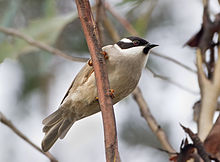- Strong-billed Honeyeater
-
Strong-billed Honeyeater 
Conservation status Scientific classification Kingdom: Animalia Phylum: Chordata Class: Aves Order: Passeriformes Family: Meliphagidae Genus: Melithreptus Species: M. validirostris Binomial name Melithreptus validirostris
(Gould, 1837)Synonyms Eidopsarus bicinctus Swainson
The Strong-billed Honeyeater (Melithreptus validirostris) is a species of bird in the Meliphagidae family. It is one of two species of the genus Melithreptus endemic to Tasmania. Its natural habitat is temperate forests.
Contents
Taxonomy
The Strong-billed Honeyeater was first described by ornithologist John Gould in 1837.[1] Its specific name is derived from the Latin words validus "strong", and rostrum "bill".[2] It is a member of the genus Melithreptus with several species, of similar size and (apart from the Brown-headed Honeyeater) black-headed appearance, in the honeyeater family Meliphagidae. Molecular markers show the Strong-billed Honeyeater separated from the common ancestor of the Brown-headed and Black-chinned Honeyeaters between 6.7 and 3.4 million years ago.[3]
The next closest relative outside the genus is the much larger but similarly marked Blue-faced Honeyeater.[4] More recently, DNA analysis has shown honeyeaters to be related to the Pardalotidae (pardalotes), Acanthizidae (Australian warblers, scrubwrens, thornbills, etc.), and the Maluridae (Australian fairy-wrens) in a large Meliphagoidea superfamily.[5]
Description
A mid-sized honeyeater at 16.5–17.5 cm (6.5–7 in) in length, it is olive brown above and pale grey brown below, with a black head, nape and throat white patch over the eye and a white crescent-shaped patch on the nape.[6] Juveniles have brownish crowns, lemon tinged nape and an orange base of bill.[7] Its call is a loud cheep cheep, or a churring.[6]
Ecology
The Strong-billed Honeyeater is found in mature forest with large trees such as Eucalyptus regnans and E. delegatensis. Its diet is principally insects and various other invertebrates, which it hunts on tree trunks, supplemented by nectar and fallen fruit.[7] Although both species are widespread in Tasmania, the Strong-billed rarely overlaps in site and foraging with the Black-headed Honeyeater.[8]
Reproduction
Strong-billed honeyeaters may nest from September to January, breeding once or twice during this time. The nest is a thick-walled bowl of grasses and bits of bark in the fork of a tall tree, usually a eucalypt. Two or three eggs are laid, 22 x 17 mm and shiny buff-pink sparsely spotted with red-brown.[9]
References
- ^ Gould, John (1837). A Synopsis of the Birds of Australia, and Adjacent Islands. London.
- ^ Simpson DP (1979). Cassell's Latin Dictionary (5 ed.). London: Cassell Ltd.. pp. 525, 629. ISBN 0-304-52257-0.
- ^ Toon A, Hughes JM, Joseph L (2010). "Multilocus analysis of honeyeaters (Aves: Meliphagidae) highlights spatio-temporal heterogeneity in the influence of biogeographic barriers in the Australian monsoonal zone". Molecular Ecology 19 (14): 2980–94. doi:10.1111/j.1365-294X.2010.04730.x. PMID 20609078.
- ^ Driskell, A.C., Christidis, L (2004) Phylogeny and evolution of the Australo-Papuan honeyeaters (Passeriformes, Meliphagidae) Molecular Phylogenetics and Evolution 31 943–960
- ^ Barker, F.K., Cibois, A., Schikler, P., Feinstein, J., and Cracraft, J (2004) Phylogeny and diversification of the largest avian radiation. Proceedings Natl. Acad. Sci., USA 101 11040-11045
- ^ a b Watts, Dave (2006) [1999]. Field Guide to Tasmanian Birds (2nd ed.). Frenchs Forest, NSW: New Holland Press. p. 145. ISBN 1-876334-60-6.
- ^ a b "Strong-billed Honeyeater". Birds in Backyards. Birds Australia. 17 May 2006. http://birdsinbackyards.net/species/Melithreptus-validirostris. Retrieved 28 June 2010.
- ^ Slater, Peter J. (1994). "Niche Overlap Between Three Sympatric Short-billed Honeyeaters in Tasmania". Emu 94 (3): 186–192. doi:10.1071/MU9940186.
- ^ Beruldsen, Gordon (2003). Australian Birds: Their Nests and Eggs. Kenmore Hills, Qld: self. pp. 314–315. ISBN 0-646-42798-9.
- BirdLife International 2004. Melithreptus validirostris. 2006 IUCN Red List of Threatened Species. Downloaded on 26 July 2007.
External links
Categories:- IUCN Red List least concern species
- Melithreptus
- Birds of Australia
- Tasmanian restricted-range endemic bird species
- Animals described in 1837
Wikimedia Foundation. 2010.

